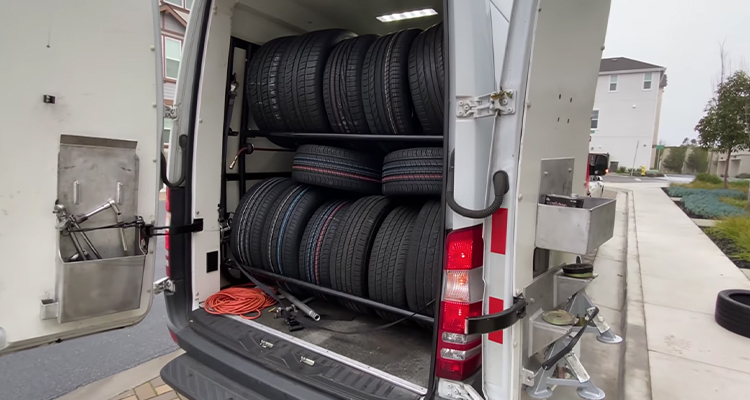Tire Solution: Proven Techniques for Ideal Tire Maintenance and Treatment
Maintaining ideal tire condition is vital for both safety and security and efficiency of any car. From making certain correct tire pressure to normal rotation and positioning, there are tried and tested methods that can significantly prolong the life-span of your tires and boost general driving experience. As we check out the ins and outs of tire treatment and maintenance, we will reveal vital standards that every vehicle owner must stick to for the very best possible results. Let's look into the world of tire service and find the secrets to keeping your tires in top-notch form for the long run.
Significance of Tire Pressure
Sufficient tire stress advertises far better gas effectiveness, as under-inflated tires can lead to increased rolling resistance, creating the engine to work harder and take in even more gas. Proper tire pressure guarantees even walk wear, boosting tire longevity and conserving money in the lengthy run by postponing the requirement for early substitutes. On a regular basis inspecting and readjusting tire stress, particularly in the past long trips, is a simple yet effective method to improve car performance, prolong tire life-span, and focus on security on the roadway.
Tire Rotation Guidelines
When considering tire rotation guidelines, it is vital to understand the importance of this upkeep job in optimizing tire life-span and keeping optimum lorry performance. Tire turning includes altering the position of each tire on a vehicle to ensure also tread wear. Front tires tend to wear quicker than back tires because of steering forces, making normal rotation critical for balanced wear patterns. The recommended turning pattern differs depending on whether a lorry is front-wheel, rear-wheel, all-wheel, or 4x4. Usually, tires ought to be turned every 5,000 to 7,500 miles, or as suggested in the automobile manual. Neglecting tire turning can bring about irregular wear, impacting handling, traction, and possibly compromising car safety and security. By sticking to appropriate turning guidelines, drivers can expand the life of their tires, boost fuel performance, and improve total driving experience. Routine rotation is a simple yet efficient maintenance method that contributes substantially to tire longevity and automobile performance.

Benefits of Wheel Placement
Guaranteeing appropriate wheel placement after tire turning is essential for keeping balanced wear patterns and making the most of automobile efficiency. Wheel placement describes the adjustment of the angles of the wheels to the producer's specs. Among the crucial advantages of wheel positioning is boosted guiding and handling response. When the wheels are appropriately lined up, it minimizes guiding effort, guaranteeing a smoother and extra controlled driving experience. Additionally, appropriate wheel alignment helps to expand the life expectancy of your tires. Misaligned wheels can create unequal tire wear, causing premature tire replacement and increased upkeep costs.

Tire Footstep Deepness Check
Doing a normal examination of tire tread depth is important for preserving safe driving problems and prolonging the life expectancy of your tires. The walk on your tires plays an essential function in offering grip, specifically in slippery or wet conditions. To inspect your tire tread depth, you can use a tread deepness scale or the dime test. The suggested walk depth is at least 2/32 of an inch. If the tread deepness is below this threshold, it is time to replace your tires to ensure optimal performance and security on the road. Unequal tread wear can indicate concerns with tire stress, suspension, or positioning, highlighting the relevance of routine walk deepness checks. Overlooking to keep track of and maintain correct walk depth can cause lowered grasp, longer braking ranges, and a boosted risk of hydroplaning. By Look At This including tire step deepness explore your regular maintenance timetable, you can drive with self-confidence recognizing that your tires remain in top problem.
Seasonal Tire Examination
An extensive evaluation of tire problem tailored to particular climate condition is websites important for keeping optimal performance and security throughout the year. Seasonal tire examination is a fundamental aspect of tire maintenance that makes sure tires prepare to face the difficulties postured by different climate condition. To prepare for winter season, it is necessary to examine the tire pressure frequently as cool temperature levels can create tire stress to drop. Inspecting tire step depth is likewise crucial to make certain ample grip on snow and frozen roads. Additionally, looking for signs of deterioration, such as fractures or bulges, can aid prevent potential tire failures. As the periods adjustment, it is very important to analyze tire problem and make any type of needed modifications to ensure risk-free driving. By carrying out regular seasonal tire examinations, vehicle drivers can lengthen tire life-span, improve fuel performance, and most significantly, make sure a safe driving experience in varying weather problems - Mobile Tire Service Las Vegas.
Final Thought
Finally, keeping appropriate tire pressure, rotating tires regularly, straightening wheels correctly, checking walk deepness, and conducting seasonal examinations are vital practices for ideal tire treatment. By following these verified approaches, vehicle drivers can ensure their tires last longer, execute better, and add to total car security. It is essential to prioritize tire helpful site upkeep to stop mishaps, enhance gas effectiveness, and extend the life-span of tires.
Adequate tire pressure advertises far better gas effectiveness, as under-inflated tires can lead to enhanced rolling resistance, triggering the engine to function tougher and consume more fuel.When considering tire turning standards, it is essential to understand the value of this upkeep job in maximizing tire life-span and keeping optimal lorry performance. Seasonal tire inspection is a fundamental facet of tire maintenance that makes sure tires are prepared to deal with the obstacles presented by various weather condition problems. By performing regular seasonal tire examinations, vehicle drivers can lengthen tire life-span, enhance fuel effectiveness, and most importantly, guarantee a protected driving experience in varying climate problems.
In conclusion, preserving appropriate tire pressure, revolving tires regularly, straightening wheels appropriately, checking tread deepness, and performing seasonal examinations are necessary methods for optimal tire treatment.